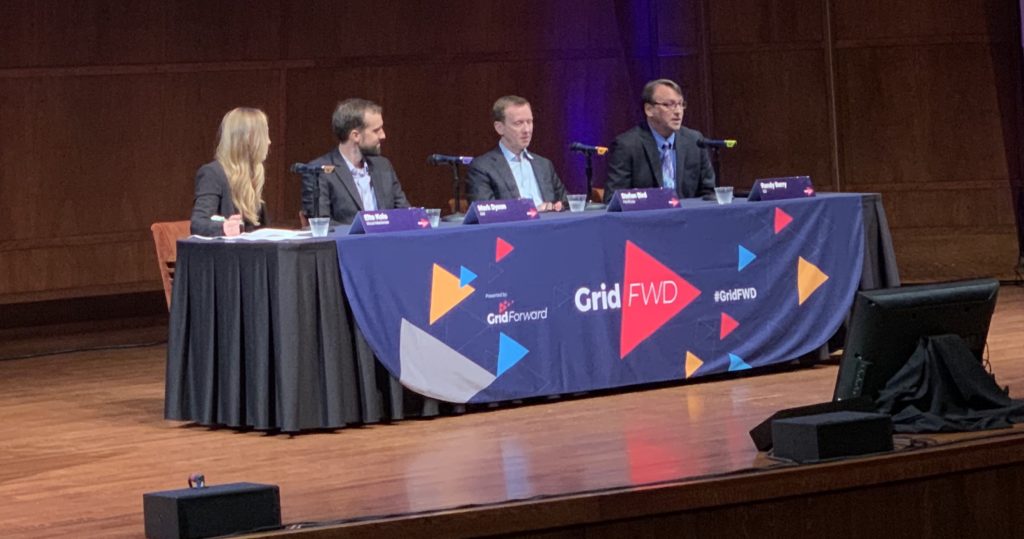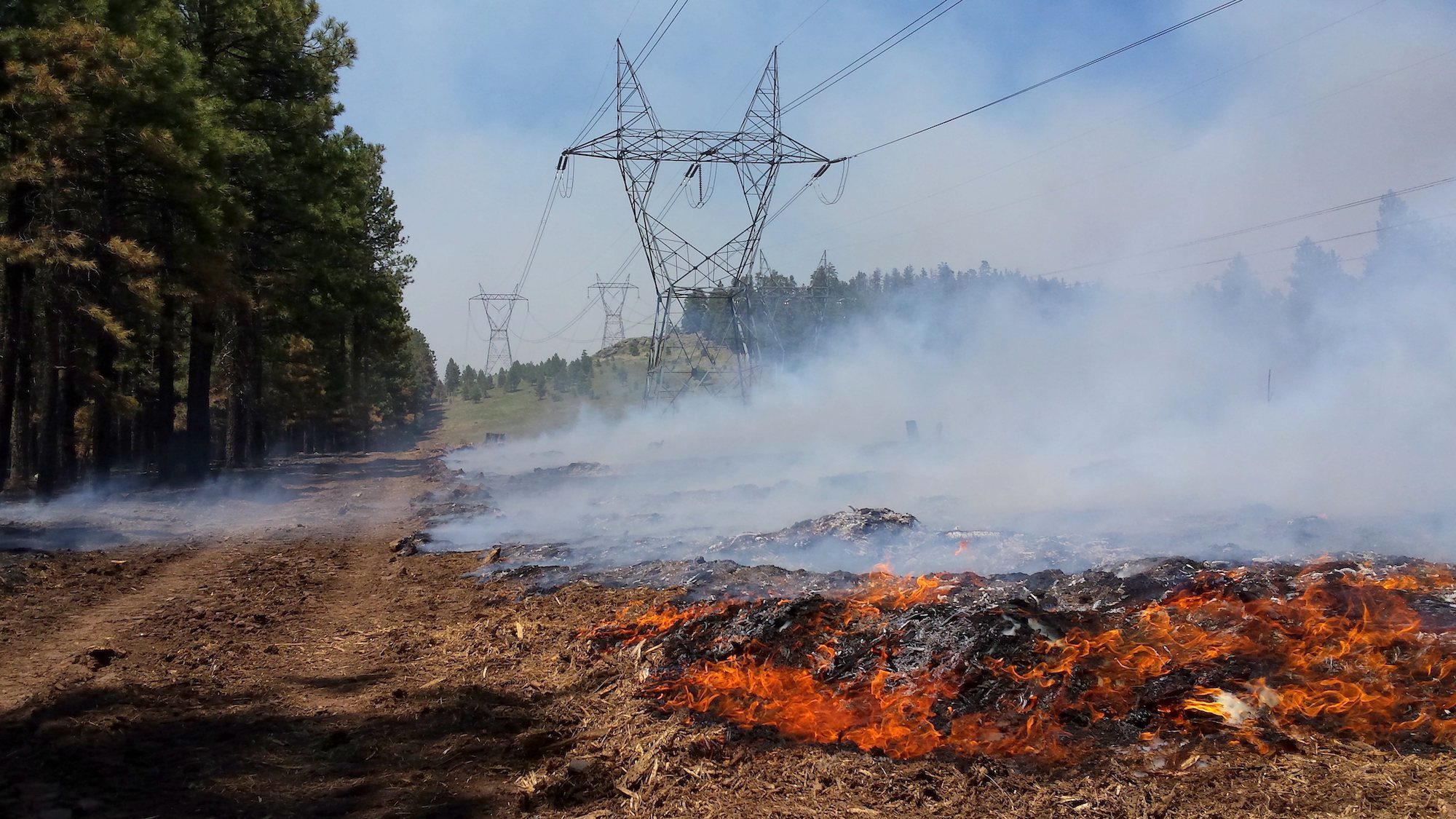Grid Modernization Perspectives from Regional Utility Leaders
GridFWD 2019 brought together over 400 regional and national experts to talk together about how to accelerate grid modernization in our region. The event’s many sessions covered grid modernization best practices, markets & models, and how to nurture a culture of innovation. Because the span of topics was so broad, and addressed by over 120 speakers, it was challenging to get a clear view of what’s immediately ahead. So we took the opportunity to ask five utility leaders who were in attendance (Steve Wright from Chelan PUD, Bear Prairie of Idaho Falls Power, Stefan Bird of Pacific Power, John Haarlow of Snohomish PUD and Jackie Flowers from Tacoma Public Utilities) about their views on what grid modernization looks like for 2020.
We’ve combined their answers into a two part series. This is part 2; click here for part 1.

Q3 – If you could make one change in policy or regulation or business model processes to facilitate modernizing your grid, what would it be?
This was a tough question for our utility executives, because there are so many areas of innovation to explore and pursue. In some cases, the focus is on internal business models.
Haarlow explained that the focus for change at Snohomish PUD needs to be on systems and business model processes. “I think about this from a cultural standpoint as well: how we think about processes and breaking silos to better utilize our systems and not doing things from a business as usual paradigm,” he said. Utility management needs to provide the ‘air cover’ for employees to take calculated risks – that may fail – and develop a culture of continuous improvement. “It excites me to see the changes that will come from this approach.”
At Chelan PUD, one key challenge to modernization is the capability to successfully implement a wide array of modernization projects outlined in Chelan PUD’s 5-year business plan, many of them driven by the need for IT infrastructure upgrades. “IT project management is different from traditional project management and engineering project management. That may make everyone nervous about moving forward with IT projects.”
Other utilities see the primary challenges in the markets and regions they operate within. Every utility has its own set of circumstances. Prairie explained that Idaho Falls does not have the same regulatory burden as an investor-owned utility, but it does struggle with not being a balancing authority nor having a robust capacity market. When talking about dispatchable load with industrial customers, Bear commented, “They say, ‘Well, what’s the value pitch?’” That’s hard to determine for a customer of a smaller utility or municipal utility inside a larger balancing authority. In fact, it can be hard for a small utility to simply find the right avenue or policy to pursue this. Bear added, “The market’s not developed to that point.”
While that challenge exists at the local scale, the regional market is also somewhat undeveloped. “Regional cooperation on transmission expansion and market optimization is one of the most pressing issues facing the West,” Bird noted. An expanded and modernized grid is critical to unlock all the diverse renewable generation, customer demand and demand response resources “for the West to grow and compete on a national and global scale,” Bird added.
Bird pointed to the expansion of the Energy Imbalance Market (EIM) as a sign of progress in this area. The EIM has nine utility partners and 11 more players joining by 2022, and the customer benefits are measurable and increasing. “To date, this market has saved customers $730 million West-wide and over $200 million savings for PacifiCorp customers,” Bird stated, “while simultaneously reducing PacifiCorp’s CO2 emissions by 15 million tons.”
Jackie Flowers illustrated one regulatory challenge to the region by relating a story of a customer who wanted to convert her home’s energy source from fuel oil to electric heating and hot water and maybe even solar PV. She asked what incentives and rebates Tacoma Public Utilities could provide to help. Washington utilities are legally barred from providing incentives for fuel-switching by the state constitution. “We need more flexibility with regard to switching fuels,” Flowers said. “If we’re going to talk about deep decarbonization in the building industry, we’re talking about switching how we heat our buildings, right?” While this example does not directly involve modernizing the grid, it shows how utility innovation that serves the community’s broader environmental goals can run into legal roadblocks.
Q4 – How are you nurturing a spirit of innovation in your organization?
Every one of our utility leaders believe business innovation is critical to hitting new business goals. They agree that change starts at the top, with a culture that nurtures thinking out of the box, risk taking, learning from failures, collaboration and diversity of opinion. Their comments are colored by the types of organizations and geographies they serve:
- Jackie Flowers: “The last thing I want to do is sit in a meeting and have everybody agreeing with me, because I know I’m not the smartest person in the room. I’m a firm believer that if you don’t have a culture where people feel like they can offer their input, they’re not going to innovate because they’re not going to step out and risk having a failure. We need to be open to failing fast, failing forward and learning from it and not be afraid to move for fear that it may not reflect me in a positive light.”
- Stefan Bird: “Our shared purpose to bring the best of the West to our customers’ door and make their lives better every day. We are transforming and disrupting ourselves by setting a bold vision for the future and breaking down our “siloes of excellence” to collaborate internally and externally.
- Bear Prairie: “We’re trying to make sure that [employees are] supported from the top down in the management team… Failures are okay as long as we’re learning from them, we’re growing. And the other thing is anytime we have outages or anything happen, we’re bringing everybody in to talk about, in a collaborative fashion, what did we learn from this.”
- John Haarlow: “It’s really being supportive and encouraging folks to step out a little bit and be willing to not steadily settle for status quo. We can support them so they will be more willing to take a risk, willing to look at things a little differently. If there’s some things to learn, that’s okay, that’s great in fact. We’ll learn and tweak and adjust as we go forward.”
At Chelan PUD, Steve Wright talked about the need to make sure that innovation is not isolated to certain groups within the utility, but supported across the organization. “We’re trying to use technology roadmaps to force conversations within the organization about what is the real value of these various different types of initiatives. Where are the resources that support it? What’s the priority so that you’re actually getting clarity around ‘this great innovative idea has priority over that innovative idea.’ And always doing that in a context of what is the value to our customers?”
Q5 – What role do you see for Grid Forward in helping the region accelerate grid modernization?
Grid modernization transcends the fundamental role of utilities to provide reliable, affordable power to communities. It encompasses broader societal goals of decarbonization, resilience to extreme events, and greater equity in the benefits of a decentralized power infrastructure. GridFWD 2019 made these topics available to explore by a wide range of representatives from industry and communities. So it’s not surprising that, when we asked these executives what role the Grid Forward organization should play in helping them pursue modernization, they pointed to the need to bring together multiple utilities, and multiple kinds of stakeholders, so they can learn from each other and develop new visions together
- John Haarlow: “The power of Grid Forward is connecting people. This includes connecting people in the utility industry with the technology providers that enable our strategic priorities in serving our customers and communities. To me that’s huge. Grid Forward is also a source of awareness, education and success stories.”
- Jackie Flowers: “The utility of the future is going to be positioned to be a platform to integrate all of these services, but it’s not necessarily going to be the technology provider. So we have to get comfortable sitting with the technology leaders, those in the industry that are really driving transformative change and partnering with them. And the more that we have these kinds of opportunities where we’re able to network across industries, the more comfortable we’ll be, and we’ll start to understand each other’s business model about how we can work together.”
- Bear Prairie: “It’s a great venue that has all the different segments of the electricity business, from universities and research to vendors and suppliers and software and traditional utilities, all coming together to talk about what’s in the future.”
- Steve Wright: “Innovation is not about coming up with great ideas in your head. It’s being able to hear from lots of different people, understand what it is that they’re doing, relate that back to your mission and vision, and being able to grab the good idea that really creates value for your customers and run with that. And then also to be able to learn from their experiences so you don’t make the same mistakes that they have. That, to me, is the key to innovation.”
- Stefan Bird: “To truly unlock the diversity of the West, to connect to more of the lower-cost, reliable and clean power our customers want, that requires moving beyond discrete, small solutions and taking a systems-approach to rapidly scale and fully realize the opportunities ahead. How can we work together to pursue the systems and connections necessary to make the Western grid and our local Western economies stronger?”
This is the second article in a two-article series. Read Part 1 here.
### This article was sourced by David Smith and Miki Carlton, and written by David Smith and Lauren Bhaskar.



